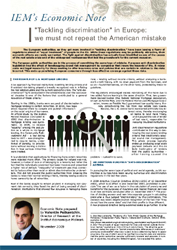« Tackling discrimination » in Europe: we must not repeat the American mistake
Economic Note / November 2009

The European authorities, as they get more involved in “tackling discrimination,” have been issuing a flurry of regulations aimed at “equal treatment” of people in the EU. While these regulations may be politically attractive, their economic effects are rarely warranted. The fight against discrimination has actually been identified as one of the causes of the real estate crisis and of the widespread recklessness that laid the groundwork for the current recession.
The European public authorities are in the process of committing the same type of mistake. European anti-discrimination legislation has the effect of handicapping sound risk management by companies that insure the hazards of life. It raises costs and legal insecurity for those seeking to offer insurance rates and policies that are realistic in relation to the risks incurred. This ends up penalising European consumers through less effective coverage against these risks.
The example of U.S. mortgage lending
A lax approach by financial institutions in setting lending criteria and ill-advised risk-taking played a broadly recognised role in inflating the real estate bubble and the current economic crisis. The “anti-discrimination” fight conducted in the United States over the last several decades is one of the factors that contributed to a general relaxation of these criteria.[[See Stan Leibowitz, “Anatomy of a Train Wreck Causes of the Mortgage Meltdown,” Independent Policy Report, Independent Institute, October 2008, available at: http://www.independent.org/publications/policy_reports/detail.asp?type=full&id=30.]]
Starting in the 1980s, banks were accused of discrimination in mortgage lending to certain minorities. In 1989, new legislation required them to compile and publish information on the racial origins of borrowers. An official study by the Boston Federal Reserve concluded in 1992 that discrimination in mortgage lending was systematic. In 1995, to impose “equality” among the population as a whole in mortgage lending, the Community Reinvestment Act – a law dating back to 1977 – was strengthened to require banks, under threat of penalty, to provide loans without making a distinction in how various minorities were treated.
It is undeniable that applications for financing from certain minorities were rejected more often. The primary cause for refusal was not, however, a matter of race or of belonging to a minority but rather the fact that the individuals concerned had lower incomes and presented a higher risk of default. “Inequality” of treatment was thus connected to factors other than racial or ethnic discrimination by underwriters. This did not prevent the public authorities from pressing the banks to relax their normal lending criteria, thereby easing access to home ownership by all minorities.
Even if the banks sought to remain prudent in managing non-payment risk correctly, they faced the peril of being accused of discrimination. Institutions that showed few scruples in managing these risks – lending without income criteria, without analysing a borrower’s credit history, with no down payment from the borrower, and so on – found themselves, on the other hand, protected by these regulations.
The regulations encouraged excess risk-taking all the more due to two added factors leaning in the same direction. First, two government-backed bodies (the Federal National Mortgage Association, known as Fannie Mae, and the Federal Home Loan Mortgage Corporation, known as Freddie Mac) guaranteed low-quality loans, thereby collectivizing the risk from real estate loan losses. Second, the U.S. central bank maintained artificially low interest rates, thereby encouraging all banks to lend more freely, and it played the role of lender of last resort, responsible for rescuing troubled institutions.
Anti-discrimination regulations contributed in this way to destroying the real estate lending criteria that traditionally assured sound risk management. This whole process logically ended up producing large-scale payment defaults and the de facto bankruptcy of lenders that the public authorities – after having caused the problem – rushed in to save.
An ambitious European “anti-discrimination” agenda
In pursuing the same type of political and social agenda, public authorities in Europe have been issuing numerous anti-discrimination regulations in the last few years.
A 2004 directive (Council Directive 2004/113/EC of 13 December 2004), which took effect in late December 2007, prohibited in principle “the use of sex as a factor in the calculation of premiums and benefits for the purposes of insurance and related financial services in all new contracts concluded after 21 December 2007.”[[See “The principle of equal treatment for men and women outside the labour market,” available at: http://tinyurl.com/yj5wolu. The directive gave member states the option to “permit proportionate differences in individuals’ premiums and benefits” when sex is seen to be a determining factor in assessing risks, the use of which would be justified by actuarial data and statistics that the public authorities consider sufficiently relevant and accurate. A number of countries, including the United Kingdom, have enacted this option.]] The practice of dividing women and men into separate groups in calculating premiums is thus judged “discriminatory” by the Commission. This decision was taken despite explicit recognition of the fact that “they do not face the same risks” and that their profile is thus different.
A new proposed directive being examined seeks to go further. It aims for “equal treatment” regardless of a person’s religion, convictions, disability, age or sexual orientation.[[See proposal for a directive COM(2008) 426 final, available at: http://eur-lex.europa.eu/LexUriServ/LexUriServ.do?uri=COM:2008:0426:FIN:EN:PDF. Member states will be able to authorise “proportionate” differences in treatment when age or handicap are judged “determining” in risk assessment based on actuarial data considered “relevant and accurate” by public authorities (see Article 2 (7)).]]
Such laws will however be a source of legal insecurity for the insurance sector, which will be particularly affected because of its nature and specificities. An individual’s age, sex, disability and so forth undeniably have an impact on his risk profile and on how insurers manage it.
Differentiating and classifying risks lie at the heart of the insurance trade
To deal with the losses linked to the hazards of life, people have always sought to protect themselves by various means, including insurance contracts.
Whether as companies or individuals, Europeans took out nearly a trillion euros in insurance in 2006, and the European insurance sector plays a major economic role.[[Source: EU Financial Services: Insurance, Eurostat, 2008, available at: http://epp.eurostat.ec.europa.eu/cache/ITY_OFFPUB/KS-SF-08-075/EN/KS-SF-08-075-EN.PDF.]] In France, a household’s average insurance budget (apart from compulsory social contributions) was estimated at nearly 2,270 euros in 2007 (see Table 1 on page 3).[[See the Rapport 2009 sur l’Assurance et la Protection Sociale en Europe, Facts & Figures, 12 June 2009, available at: http://www.lesechos.fr/medias/2009/0612//300355053.pdf. ]] Some of the costliest insurance products they buy – such as automobile insurance or health assurance – risk being affected by the new European regulations.
To offer this protection against the hazards of life, insurers use many tools aimed at sound risk management. Thus, they differentiate, classify and mutualise risks that, based on their experience and the available information, appear sufficiently homogeneous to be put in a group. The work of an insurer consists primarily of identifying and mutualising, in other words, putting these risks together and then applying premiums consistent with the frequency at which risk occurs within each group.
The risk of flooding, for example, is not the same near a river as it is far inland. Accordingly, premiums should vary from one place to another. Similarly, with respect to road accidents, not all drivers present the same risk profile. It is logical, then, that premiums should vary based on a vehicle’s power, where it is normally driven (in the countryside or in large urban areas where traffic is denser), or any other factor an insurer may consider relevant.[[See, for example, the information document “Comment sont établis les tarifs d’assurance automobile?,” Fédération française des sociétés d’assurance, August 2009, available at: http://www.ffsa.fr/WebFFSA/portailffsa.nsf/html/tarifsauto/$file/FP101aout09.pdf. ]] Among risk differentiation criteria, an individual’s personal characteristics may, naturally, also play a role. Insurers thus try to take account of a driver’s experience behind the wheel and his way of driving, which may or may not be likely to cause an accident.
In an ideal world where information is perfect, insurers would have no problem determining risks and classifying them. In the real world, however, information is always imperfect, and uncertainty about the future is always present. Insurers do not have every possible means of directly evaluating risks linked to an individual’s personal factors. In automobile insurance, for example, they cannot know whether or not a particular individual is a safe driver.
Insurers, though, are not totally helpless regarding this situation of incomplete information. Through past experience (although it is not always quantifiable), and also by accumulating statistical data and acquiring relevant information, they find that some personal characteristics are associated with a systematically more frequent occurrence of the risk they wish to insure.[[Regarding the importance of this process of statistical inference and how anti-discrimination measures undermine its use, see Ben O’Neil, “The Antidiscrimination Paradigm: Irrational, Unjust, and Tyrannical,” The Independent Review, Vol. 13, No. 4, spring 2009, pp. 533-534, available at: http://www.independent.org/publications/tir/article.asp?a=728. ]] The art of insuring lies in putting together risk groups that are as homogeneous as possible, based on an individual’s profile.
Experience shows that women present less risk at the wheel[[See, for example, “Private Motor Insurance by Age and Gender,” Association of British Insurers, June 2008, available at: http://www.abi.org.uk/Facts_and_Figures/44435.pdf. The data show that women constitute a lower proportion of claims than men.]] and are less subject to serious illness than men.[[See “CMI Data by age and gender: Critical illness insurance,” June 2008, available at: http://www.actuaries.org.uk/__data/assets/pdf_file/0020/134381/Gender_CI.pdf.]] They thus can benefit – when regulations do not prevent this – from lower premiums for car insurance and for insurance against serious illness.[[This is a form of insurance that calls for the payment of a lump sum if an insured person is struck by a serious illness such as cancer, a heart attack, etc. (with a list that may vary from one insurer to the next).]]
Taking account of an individual’s sex, or any other parameter such as age, enables insurers to get a better idea, indirectly, of the risks they wish to insure. Forcing them to charge the same premiums and offer the same policies to all individuals amounts to considering that the risks incurred are similar, whereas in actual fact they are not. This is a source of many distortions in the insurance market.
The flexibility of insurance products is essential to sound risk management
Differentiating freely among risks, premiums and policies plays a dual role in the existence of an efficient and viable insurance sector. Anti-discrimination regulations go against this.
First, this type of flexibility enables the phenomenon of adverse selection to be managed. A lack of information means that insurers always run the risk of attracting a disproportionate number of people who present high risks. If this happens, premium levels are not sufficient to deal with hazards that in fact have been underestimated, and the insurer’s economic viability is quite simply under threat. Having insurers identify, classify and differentiate risks and premiums is thus fundamental. Using a differentiated rate structure is a way of dealing with this adverse selection phenomenon. Individuals who present a higher risk profile logically pay higher premiums for the same level of coverage.
The insurance sector also has to manage the problem of moral hazard related to the fact that insured persons who are protected against a hazard can allow themselves to be less cautious with respect to this hazard. For example, motorists with “all risk” insurance have less incentive to drive carefully and could take more risks at the wheel. It follows that if the insurer has no way of counteracting this problem, the risk has a greater chance of occurring. The existence of deductibles in insurance contracts is an example of a tool that insurers can use to manage moral hazard.
But the flexibility of insurance rates and products still remains key. Tougher penalties (loaded premiums) in case of accidents caused by young drivers (compared to all other motorists) could encourage this category of inexperienced drivers to be more vigilant on the road.
With uniform insurance rates and policies, “bad” risks and careless behaviour would tend, on the contrary, to proliferate because they would be subsidised by “good” risks, in other words people who make an effort to avoid risk and who would thus be penalised.
Premiums based on a policyholder’s profile are among the tools that are indispensable to insurers in dealing with these two phenomena that are likely to endanger their business and with it the protections provided to their various clients.
Rules that run counter to insurance logic
The European anti-discrimination directives give the appearance of recognising the specificities of insurance and the fact that there exist differences of treatment by insurers based on personal characteristics (such as a person’s age or eventual disability).[[See, for example, consideration (15) in directive COM (2008) 426, p. 15: “Actuarial and risk factors related to disability and to age are used in the provision of insurance, banking and other financial services. These should not be regarded as constituting discrimination where the factors are show to be a key factor for the assessment of risk.”]]
This new “anti-discrimination” legislation as a whole substantially blocks and deters the use of a differentiated rate structure, however.
First, the setting of differentiated premiums is subjected to a number of conditions set by the public authorities. For example, the directive enables lawmakers to decide whether or not a factor such as sex, age or disability is “determining.” These criteria will be imposed arbitrarily on insurers who, contrary to the public authorities, are specialists in risk assessment. An overly restrictive definition of what is considered “determining” by the public authorities will prevent insurers from managing risk effectively.
When subjected to market rules (in particular the risk of bankruptcy), insurers have the incentives needed to use the most accurate statistical and actuarial data possible in varying their rates. If they fail to do so, they create an opportunity for competitors to offer better targeted and better priced products and thus to take market share from them. This competitive process of trial and error by all insurers on the market is crucial in discovering and recalibrating the data and information needed to assess risk as effectively as possible.
However, intervention by the public authorities will inevitably harm this competitive process. If the data presented by an insurer are not judged relevant by the public authorities, the new legislation will prevent the insurer from offering differentiated premiums, at the risk of throwing its accounts off balance.
Rather than seeking and collecting information that they – at their own peril – consider useful in managing their risks, insurers will have an incentive to gather and publish information with the sole aim of complying with official requirements and showing they do not discriminate, which is not their job.
Second, the burden of proof is reversed. Insurers are presumed guilty of discrimination if they do not offer uniform premiums. Insurers who decide nonetheless to offer differentiated rates will be easy to attack in court and will have to cover additional costs, even if in the end they had sound reasons for applying such rates.
The costs related to complying with the legislation and the legal insecurity resulting from it will substantially limit, or even end, practices of rate differentiation based on objective criteria (age, sex, etc.). Blocking rate modulation will stop insurers from doing their job properly by preventing them from managing the problems of adverse selection and moral hazard effectively. That will cause insurance market to fail.
Consumers will end up being penalised
A single rate structure or insufficient risk differentiation will clearly benefit, in the short term, those viewed as “victims” of discrimination, who will in fact be subsidised by the regulations.
But this type of reform will inevitably penalise all other policyholders, who will have to finance these “subsidies” through higher premiums or deductibles. The consequences of “anti-discrimination” regulations will be felt especially by groups of individuals who, though not necessarily wealthier than those they are “subsidising,” present less risk.
For example, in the absence of a distinction based on sex, women could be penalised in automobile insurance or insurance against serious illness. In health or life insurance, young and healthy policyholders will be called upon to subsidise individuals who are older and in general wealthier.
In the longer term, the costs related to implementing and enforcing this “anti-discrimination” social agenda and the insurance market failures it will cause will be borne by all consumers. With insurers unable to manage the phenomena of moral hazard and adverse selection suitably, excessive risk-taking will be encouraged by the regulations. This will put up the cost of insurance policies and could even push insurers to cease offering certain contracts. Insured persons will be the big losers.
Conclusion
The social agenda of tackling discrimination poses insurmountable obstacles to sound risk management. The experience of U.S. mortgage loans shows that relaxing lending criteria generated large-scale perverse effects. It made both lenders and borrows more vulnerable, laying the groundwork for a worldwide financial crisis.
In Europe, the powerful rise of EU and national regulations is likely to bring about pernicious effects of the same sort by preventing insurers from doing their job. As in the United States, there is a risk that this poorly understood chain of events could also provide a pretext for implementing more regulations, producing added distortions.
We must not repeat the American mistake. If consumers wish to benefit from highly developed and efficient protection against the hazards of life, it is fundamental for the private insurance sector to escape European “anti-discrimination” legislation.





